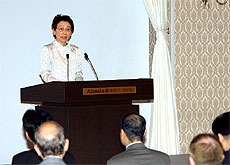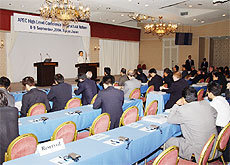Opening Remarks by Her Excellency Yoriko Kawaguchi,
Minister for Foreign Affairs of Japan
at the APEC High Level Conference on Structural Reform
 |
 |
8 September 2004
Good morning,
Excellencies,
Distinguished guests,
Ladies and Gentlemen,
It is my great pleasure to welcome all distinguished speakers and participants, and to host the APEC High Level Conference on Structural Reform here in Tokyo. On behalf of the Government of Japan, I would like to extend my warmest welcome to you all for participating in this conference.
Prime Minister Junichiro Koizumi, since assuming office, has demonstrated his determination to promote structural reform, advocating the following three principles: first, "without reform there will be no growth"; second, "leave to the private sector what it can do"; third, "leave to the localities what they can do." As his bold and efficient reforms in the areas of finance, tax system, regulations and expenditure have born fruit, the Japanese economy has been recovering, while further advancing domestic reform.
Structural reform enables us to revitalize our domestic economy as well as to fully enjoy benefits from the globalized economy. A certain degree of pain always accompanies the reform process. But since the Japanese economy is continuing to show strong signs of recovery, now is the time to grow the sapling of the reform into a healthy and strong tree.
Building on the lessons learned from our bittersweet experiences, Japan proposed that APEC accelerate structural reform collectively. As we successfully overcame the 1997 Asian Financial Crisis and the SARS Crisis of last year through substantial reform of the domestic economy and close regional cooperation, I am convinced that structural reform is central to successfully addressing the challenges caused by economic shocks, and to achieving sustainable economic growth in the Asia-Pacific region.
At the APEC Leaders' Meeting in Bangkok last October, pursuant to the proposal put forward by Prime Minister Koizumi, APEC Leaders made a political commitment to accelerate structural reform in each economy as well as in APEC as a whole. Such a wide and strong support by the APEC Leaders convinced us that our firm belief on the promotion of structural reform is now commonly shared by the APEC Economies. Today, we have witnessed the world economy's steady recovery and the favorable trends in Asian business. Promoting structural reform in each economy in this circumstance will be opportune to create a virtuous cycle of sustained growth and continued structural reform.
Almost fifteen years have passed since the inception of APEC in 1989. My dedication to APEC has been something special. Just after its foundation, I had the opportunity to work as an APEC Senior Official for Japan. Since then, APEC has aimed to achieve free and open trade and investment in Asia-Pacific, but its efforts have been concentrated mainly on "at the border" measures, such as reducing tariffs or facilitating export and import procedures. Pursuing structural reform, however, will bring added-value to APEC in the following two perspectives:
Firstly, structural reform initiatives in APEC bring our focus not only to the "at the border" measures, but also to the "behind the border" measures. Structural reform will assist in realizing the benefits of trade and investment liberalization and facilitation not only in its own economy, but also in APEC as a whole. Equally, addressing APEC's wide-ranging coverage of economic issues under the context of "structural reform" will contribute to crosscutting and creating synergy among APEC's traditional sector-wise issues such as regulatory reform or competition policy.
Secondly, the FTAs which many member economies are pursuing today cannot be expedited without domestic structural reform. With the expectation of future development of a mega-market in our region, structural reform will be the major step towards possible trade and investment liberalization. As the APEC Chair economy, Chile, is taking the lead to facilitate FTAs as a leverage to promote trade and investment liberalization in the Asia- Pacific region. I strongly believe that this approach is appropriate in the sense that the conclusion of FTAs, just like reaching agreements within the WTO, cannot be accomplished without enhancing the competitiveness of domestic industries in each economy through structural reforms.
I am sure that the APEC High Level Conference on Structural Reform of today and tomorrow will bring the momentum to accelerate structural reform in APEC. The conference fortunately has attracted more than thirty eminent speakers, from government, business and academia from and beyond the APEC region. I expect a constructive discussion on the extensive issues that encompass structural reform as covered in our agenda: experiences on regulatory reform including Japan's Special Zones for Structural Reform; successful corporate and banking sector reform; economic and social adjustment necessary to implement reforms; and fostering fair and transparent economic and legal infrastructure.
APEC's work on structural reform enables us to establish resilient and open markets. In the current regional economic integration, the successful APEC initiatives will make the Asia-Pacific region the driving force for continued growth in the world economy.
As a result of extensive discussion, I look forward to tangible and constructive proposals towards the APEC Leaders' Meeting in November in Santiago.
Thank you very much for your attention.
[END]
Back to Index
